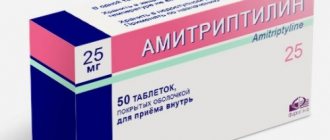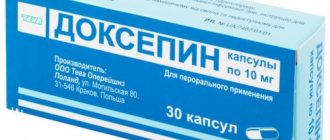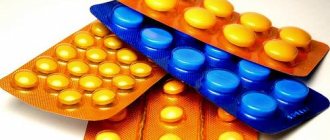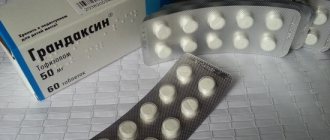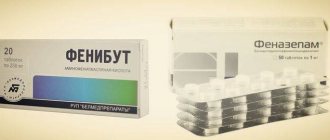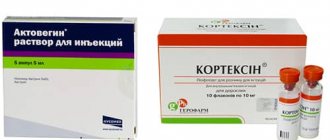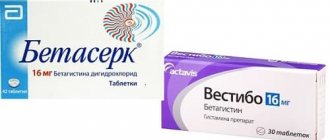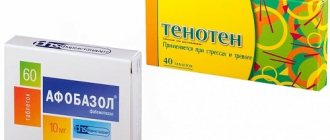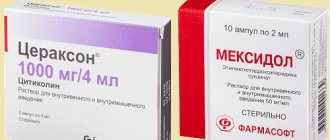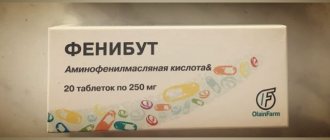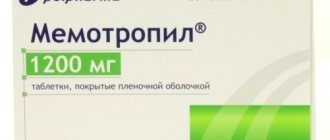pharmachologic effect
An antidepressant from the group of selective serotonin reuptake inhibitors. It has a thymoanaleptic and stimulating effect.
Selectively blocks the reverse neuronal uptake of serotonin (5HT) at the synapses of neurons in the central nervous system. Inhibition of serotonin reuptake leads to an increase in the concentration of this neurotransmitter in the synaptic cleft, enhancing and prolonging its effect on postsynaptic receptor sites. By increasing serotonergic transmission, fluoxetine inhibits neurotransmitter metabolism through the negative membrane binding mechanism. With long-term use, fluoxetine inhibits the activity of 5-HT1 receptors. Weakly affects the reuptake of norepinephrine and dopamine. It has no direct effect on serotonin, m-cholinergic, H1-histamine and alpha-adrenergic receptors. Unlike most antidepressants, it does not cause a decrease in the activity of postsynaptic beta-adrenergic receptors.
Effective for endogenous depression and obsessive-compulsive disorders. It has an anorexigenic effect and can cause weight loss. Does not cause orthostatic hypotension, sedation, and is noncardiotoxic. A lasting clinical effect occurs after 1-2 weeks of treatment.
Zoloft. Indications for use
Why is this drug prescribed?
Depression is a rather painful condition. In which the taste of food, sex and other joys of life is largely lost.
And so, sometimes the following happens. All life's joys are blocked or covered with a gray fog, except one! For example, a depressed person finds his satisfaction only in food... Or in sex, in this very libido. Thus, by the way, really helping yourself with the antidepressant effect of sexual contacts, in any form.
They began to treat - and suddenly this joy disappeared or decreased! Really unpleasant.
However, let me remind you that this does not happen often, the reduction effect is temporary, and there are alternative methods. From another drug (with a different mechanism of action) to non-drug methods.
Use other drugs
Another drug may have more side effects than the one described by Zoloft, but will not affect libido! Here you have to choose. I personally chose Zoloft, along with a couple of others, for optimal harmlessness.
Non-drug treatments for depression
A completely separate conversation. And it’s not suitable for everyone, and it requires more strength. But there are also advantages, undoubtedly. Everyone interested is carefully studying the book by V. Levi “People are lucky!” - IMHO the best on this topic, the basic one. Undoubtedly, this technique can and should be expanded.
Pharmacokinetics
When taken orally, the drug is well absorbed from the gastrointestinal tract (up to 95% of the dose taken); administration with food slightly inhibits the absorption of fluoxetine. Cmax in blood plasma is reached after 6-8 hours. The bioavailability of fluoxetine after oral administration is more than 60%. The drug accumulates well in tissues, easily penetrates the blood-brain barrier, binding to blood plasma proteins is more than 90%. Metabolized in the liver by demethylation to the active metabolite norfluoxetine and a number of unidentified metabolites. It is excreted by the kidneys in the form of metabolites (80%) and the intestines (15%), mainly in the form of glucuronides. T1/2 of fluoxetine after reaching equilibrium concentration in the blood plasma is about 4-6 days. T1/2 of the active metabolite of norfluoxetine with a single dose and after reaching equilibrium concentration in the blood plasma ranges from 4 to 16 days. In patients with liver failure, the half-life of fluoxetine and norfluoxetine is prolonged.
Comparison of the effectiveness of Adaptol and Amitriptyline
Amitriptyline is more effective than Adaptol - this means that the ability of the drug substance to provide the maximum possible effect is different.
For example, if the therapeutic effect of Amitriptyline is more pronounced, then with Adaptol it is impossible to achieve this effect even in large doses.
Also, the speed of therapy is an indicator of the speed of the therapeutic action; Amitriptyline and Adaptol are also different, as is bioavailability - the amount of the drug reaching the site of its action in the body. The higher the bioavailability, the less it will be lost during absorption and use by the body.
Contraindications
- simultaneous use with MAO inhibitors (and within 14 days after their discontinuation)
- simultaneous use of thioridazine (and for 5 weeks after discontinuation of fluoxetine), pimozide
- pregnancy
- breastfeeding period
- severe renal impairment (creatinine clearance less than 10 ml/min)
- liver failure
- lactase deficiency, lactose intolerance, glucose-galactose malabsorption
- age up to 18 years
- hypersensitivity to the drug.
Carefully
Suicidal risk: with depression, there is a possibility of suicide attempts, which may persist until stable remission occurs. Isolated cases of suicidal thoughts and suicidal behavior have been described during therapy or shortly after its completion, similar to the effects of other drugs with similar pharmacological action (antidepressants). Careful monitoring of patients at risk is necessary. Clinicians should encourage patients to promptly report any distressing thoughts or feelings.
Epileptic seizures: Floxetine should be prescribed with caution to patients who have had epileptic seizures.
Hyponatremia: Cases of hyponatremia have been reported. Mostly, such cases were observed in elderly patients and in patients taking diuretics, due to a decrease in circulating blood volume.
Diabetes mellitus: glycemic control in diabetic patients during treatment with fluoxetine showed hypoglycemia; after discontinuation of the drug, hyperglycemia developed. Doses of insulin and/or oral hypoglycemic agents may need to be adjusted at the start or after treatment with fluoxetine.
Renal/liver failure: Fluoxetine is metabolized by the liver and excreted by the kidneys and gastrointestinal tract. In patients with severe liver dysfunction, it is recommended to prescribe lower doses of fluoxetine, or prescribe the drug every other day. When taking fluoxetine at a dose of 20 mg/day for two months, there were no differences in the concentrations of fluoxetine and norfluoxetine in the blood plasma of healthy individuals with normal renal function and patients with severely impaired renal function (creatinine clearance 10 ml/min) requiring hemodialysis.
Health and treatment
08:57 pm - Comparative analysis of antidepressants in “minor psychiatry”
The following text is actually notes on the cuffs. Placed here for ease of remote access. The information is technical, narrowly professional and of no interest to non-specialists
All modern antidepressants have approximately the same effect in terms of the antidepressant effect itself, but they differ significantly in their effect on concomitant symptoms and in the frequency and severity of complications. It is according to these criteria that they should be selected. Classic tricyclic ADs, as well as MAO inhibitors, still remain the “gold standard” in their antidepressant effectiveness. However, there are many restrictions on their use. TADs have many unpleasant complications; MAO inhibitors have strict requirements for compatibility with other medications and the patient’s somatic condition. Within the framework of “minor psychiatry”, they are not the drugs of choice; they should be turned to only after other options have been exhausted. For the treatment of generalized anxiety disorder, social phobia, panic attacks and major depressive disorder, the drug of choice today is selective serotronin reuptake inhibitors, SSRIs.
Serotonin reuptake inhibitors. SSRIs.
The very first one
was fluoxetine
(Prozac). The patent expired in 2001, and many generics are available. In the Russian Federation, it is available in dosages of 10 mg and 20 mg at a price of 60-80 rubles/20 tablets; at present, it has no advantages other than a low price. Side effects (comparable to placebo): nausea 24%/9%, insomnia 19%/10%, drowsiness 12%/6%, anxiety 12%/6%, nervousness 13% and 8%, asthenia 11%/6% , tremor 9% to 2%. In most cases, taking fluoxetine is accompanied by sexual dysfunctions associated with decreased libido, as well as changes in body weight. These manifestations are common to the entire group; strictly speaking, they are not complications, but they reduce the patient’s quality of life and often make admission more difficult; in fluoxetine they are most pronounced. The withdrawal syndrome is moderate and inferior to paroxetine, fluvoxamine and venlafaxine. The mechanism of action is through 5HT-2c antagonism (a type of serotonin receptor) and sigma-1 receptors (more citalopram, less fluvoxamine).
There are 5 modern SSRIs of the second generation on sale. Fluvoxamine (Fevarine), paroxetine (Paxil, Rexetine), citalopram (Cipramil), escitalopram (Cipralex) and sertraline (Zoloft, Asentra). The licenses for all of them expired in the 2000s, all of them are produced in generics. In addition to them, there is a 6th drug, vilazodone, which was only approved by the FDA in January 2011, its sales have just begun in the USA, it will not reach us soon. Plus, dapoxetine has weak antidepressant activity, as AD is not used, and is effective in the treatment of premature ejaculation in men (approved by the FDA in 2004). All second generation SSRIs have approximately the same effectiveness - about 50% result during treatment and 20% long-term remissions. All of them in 60-65% of cases cause sexual dysfunction associated with decreased libido (anorgasmia in women, difficulties with erection and ejaculation in men), as well as increased appetite and weight gain.
Sertraline
Born in 1991, license expired in 2006, in 2007 the most prescribed blood pressure. In the Russian Federation it is sold under many names - Asentra, Zoloft, Stimuloton, Serenata, Sirlift, Torin, in dosages of 50 mg and 100 mg at prices from 700 to 1400 rubles / 28 tablets. The effectiveness is comparable to the old tricyclic ADs (amitriptyline, anafranil, imipramil), but significantly fewer side effects. According to unproven information, use may exacerbate suicidal tendencies. Indicated for major depressive disorder, obsessive-compulsive disorder, generalized anxiety, panic attacks, social phobia and post-traumatic stress syndrome. 1.4 times more effective than fluoxetine. Reduces the frequency of panic attacks by 80%; Efficiency equal to paroxetine and alprazolam. Side effects (relative to placebo) - nausea 24% and 11%, insomnia 24% and 11%, diarrhea 20 and 10%, dry mouth 14 and 8%, drowsiness 13 and 7%, dizziness 12 and 7%, tremor 8 and 2 %. Sexual dysfunctions: 61-67% of men note negative consequences in their sexual life when taking sertraline. 41% of women have difficulty achieving orgasm and 12% of women have problems with the physiological component of sexual arousal (lack or insufficient hydration during arousal). These are problems common to all SSRIs; very low blood pressure (for example, nefazodone and bupropion) are not accompanied by sexual dysfunction.
Paroxetine
Born in 1992, the license expired in 2007. In the Russian Federation it is sold under the name Paxil, Adepress, Rexitin, in a dosage of 20 mg at a price of 500 to 1300 rubles / 30 tablets. The most powerful of the SSRIs, an antagonist of 5HT-1 and 5HT-2 serotonin receptors. The largest withdrawal syndrome of all SSRIs. In addition, unlike other drugs in the group, it can be used to treat premature ejaculation. There is evidence that paroxetine is effective for menopausal depression and for the treatment of compulsive gambling addiction. Contraindicated under 18 years of age (it is believed that it may exacerbate suicidal tendencies). Can be used to treat depression in older people. Side effects (comparable to placebo) - nausea 26 and 9%, drowsiness 23 and 8%, difficulty achieving ejaculation 13 and 0%, asthenia 15 and 6%, sweating 11 and 2%, dizziness 13 and 6%, insomnia 13 and 6%, dry mouth 16 and 12%, constipation 14 and 9%, tremor 8 and 2%. Paroxetine may cause manic or hypomanic states, especially in predisposed patients (up to 8%).
Fluvoxamine
Born 1993, Sold in the Russian Federation as Fevarin 50 mg and 100 mg at a price of 500-750 rubles/15 tablets. approved for the treatment of obsessive-compulsive disorder and social phobia; including in teenagers. Most often prescribed for OCD, otherwise the indications are the same as other SSRIs. After parkosetine, the second most severe withdrawal syndrome is. Sexual dysfunction is the least pronounced with fluvoxamine among all SSRIs.
Citalopram
Born in 1989, patent expired in 2003. In the Russian Federation, Tsipramil, Oprah, Siozam. 20 mg and 40 mg at a price of 900-1700 rubles/28 tablets Approved for the treatment of major depressive disorder. It is also prescribed for various anxiety disorders, but is not approved by the FDA for this purpose - panic attacks, generalized anxiety disorder, body dysmorphic disorder, OCD. Well tolerated and considered the preferred choice for elderly and medically compromised patients. It has an antihistamine effect, a drug with a moderate sedative effect. Withdrawal syndrome is average. Cross-linked with serotonin, it causes an increase in the concentration of dopamine in the intersynaptic cleft, which can lead to emotional lability and mood swings.
Escitalopram
Born in 2001, the patent is still valid (expiration date 2012). Today it is the most prescribed blood pressure in the West. In the Russian Federation it is sold as Cipralex and Selectra, 10 mg 800-1700 rubles/28 tablets. Indicated for the treatment of major depressive disorder and generalized anxiety disorder. With similar effectiveness, the least side effects among SSRIs. Relative to placebo, insomnia 14 and 4%, dry mouth 9 and 3%, drowsiness 9 and 1%, dizziness 7 and 2%, sweating 8 and 1%, constipation 6 and 1%, weakness and fatigue 6 and 2%, gastric disorders 6 and 1%.
NB!
According to NICE research for 2010, according to a meta-analysis, all SSRIs are reliably effective for severe disorders. With moderate manifestations of depression and sub-depressive background, their effectiveness differs little from placebo. Only 2 antidepressants have passed the “threshold of clinical effectiveness”: paroxetine and venlafaxine. For all others, the effectiveness was considered insufficiently reliable.
Non-SSRI BP.
Serotonin and norepinephrine reuptake inhibitors SNRIs
Due to the blockade of both serotonin and epinephrine receptors, the effectiveness is higher than for classic SSRIs and comparable to old TADs. Thus, for all SSRIs the result is achieved in approximately 50% of cases, for SNRIs this figure reaches 70%. The effect of the drugs changes as the dose is increased. In small dosages they act only as serotonin inhibitors, and at these doses the effect is no different from conventional SSRIs. But as the therapeutic dose increases, they begin to manifest themselves as norepinephrine reuptake inhibitors (to a greater extent in venlafaxine, to a lesser extent in duloxetine), and at maximum dosages a dopaminergic effect is added. Currently, there is a gradual shift in the focus of preferences from SSRIs to SSRIs. The two most commonly used drugs in this group are venlafaxine (Effector) and duloxetine (Cymbalta). This is blood pressure with a general stimulating effect. For all, withdrawal syndrome is pronounced.
Venlafaxine
Born 1993 The patent expired in 2007. Second after escitalopram in terms of sales in 2009 in the United States. The price of generics in the Russian Federation is under the name Efevelon 37.5 mg 600 rubles/30 tablets; Velafax 75 mg 500 rub/28 tablets; Velaxin 37.5 mg 670 rub/28 tablets, Velaxin 75 mg 970 rub/28 tablets. The drug, unlike SSRIs, very rarely causes sexual dysfunction and eating disorders. For moderate depressive disorder, one of two ADs (together with paroxetine) recognized by NICE as having passed the threshold of “credible clinical effectiveness.” Licensed for the treatment of major depressive disorder, generalized anxiety disorder and anxious depression. Also prescribed for social phobias and panic attacks. The effectiveness for depression is equal to amitriptyline and imipramine, and exceeds the effectiveness of sertraline and fluoxetine. A meta-analysis from 2000 showed that venlafaxine is even more effective than tricyclic blood pressure medications and is equal to bupropion, but is inferior to the latter in the number of remissions achieved. In the treatment of OCD it is equivalent to anafranil, with fewer side effects. Despite the general stimulating effect, some patients report severe sedation. Also, due to its adrenergic action, it is not indicated in the treatment of bipolar disorder or the risk of developing manic states. May increase blood pressure. Complications (compared to placebo). Nausea 37 and 11%, drowsiness 23 and 9%, dry mouth 22 and 11%, dizziness 22 and 9%, insomnia 18 and 10%, sexual dysfunction 12 and 0%, asthenia 12 and 6%, anxiety 6 and 3% . 44% of patients complain of “difficulty remembering” while taking venlafaxine. The drug has a pronounced withdrawal syndrome, similar to that of paroxetine.
Duloxetine
Recommended by the FDA for the treatment of depression and fibromyalgia in 2004; approved in 2007 for the treatment of generalized anxiety disorder. The patent has not expired and no generics are produced. In the Russian Federation it is sold under the name Cymbalta 30 mg and 60 mg from 1000 rubles/14 capsules. For mild and moderate depressive symptoms, the effect of duloxetine is slightly greater than placebo (as is the case with most ADs). When directly compared with escitalopram for the treatment of depression, duloxetine appears to be slightly less tolerable and slightly less effective. In the treatment of generalized anxiety disorder, it is absolutely similar to venlafaxine. The effectiveness in chronic fatigue syndrome is currently under debate. In addition, it is prescribed for diabetic neuropathy and urinary incontinence syndrome. Side effects correspond to venlafaxine, but are somewhat less pronounced - nausea, insomnia, drowsiness and dizziness occur in 10-20% of cases. A course of treatment requires monitoring blood pressure.
In addition to these 2 drugs, the SNRI group includes
Milnacepran
. In the US, the FDA has licensed it for fibromyalgia, but has not approved it for the treatment of major depressive disorder. Meanwhile, it is actively produced in the countries of Western Europe and Latin America as an antidepressant. In the Russian Federation it is available under the name Ixel 25 and 50 mg 1500-2000 rubles/56 tablets. A special feature of this AD is its noticeable analgesic effect, due to which it is indicated for patients with depressive disorders against the background of chronic pain syndrome. For disorders with a pronounced anxiety component, the effect of milnacepran has not been proven. Side effects are slightly (about 5%) higher than placebo. May have a depressant effect on sexual function.
Sibutramine
Not used as an antidepressant.
Used to treat obesity, reduces appetite, its effectiveness as an anorexant is close to that of amphetamines. In the Russian Federation it is sold under the name Lindaxa 10 mg and 15 mg 1200-1300 rub/30 tablets and Reduxin 10 mg and 15 mg 2400-3000 rub/60 tablets. Desvenlafaxine
(Pristiq), an active metabolite of venlafaxine, went on sale in the USA in 2008, but is not supplied to the Russian Federation.
Levomilnacepran
, an isomer of milnacepran, is currently in development.
Bicifadine
, an antidepressant effect has not been identified, is in development, is being studied as a non-opioid, non-NSAID analgesic.
Tetracyclic antidepressants.
The mechanism of action is associated with the antagonism of serotonin and adrenergic receptors, which leads to the accumulation of serotonin and norepinephrine in the intersynaptic cleft, enhancing central serotonin and noradrenergic transmission. The most popular in the class is mirtazapine (Remeron), sometimes older drugs are prescribed - mianserin (Lerivon) and maprotiline (Ludiomil).
Mirtazapine
Born 1990 In the Russian Federation it is sold under the name Remeron 0.03 1000-2500 rubles/10-30 tablets, Mirtazen 30 mg 1200 rubles/30 tablets, Mirtazonal 900 rubles/30 tablets Antagonist of 5HT-2 and 5HT-3 serotonin receptors, practically does not bind to 5HT-1. A strong antagonist of H1-histamine receptors. Weakly binds alpha-adrenergic receptors. Application: MDD, GAD, OCD, social phobia and anxiety disorder, insomnia, itching. One of the most effective ADs on the market. According to a 2009 review, it is superior to SSRIs, SSRIs, bupropion and mianserin in its antidepressant effectiveness. Superior to trazodone (trittico). Comparable to most tricyclics, including amitriptyline, doxepin and clomipramine. Inferior to imipramine. In combination with venlafaxine, it is applicable for resistant depression; the effectiveness in this segment is comparable to MAO. Causes severe sedation and drowsiness (due to pronounced histamine action), used to treat sleep disorders. Causes an increase in appetite and an increase in body weight - one of the most pronounced manifestations of all blood pressure. In addition, common side effects include dizziness, decreased cognitive function, disinhibition, blurred and tired vision, vivid and lucid dreams/nightmares, dry mouth, and constipation. According to other sources, the frequency of side effects is not so dramatic and is (relative to placebo): drowsiness 54 and 12%, dry mouth 25% (15%), increased appetite 17% (2%), weight gain 12% (2 %), constipation 13% (7%), asthenia 8% (5%), dizziness 7% (3%), unusual dreams 4% (1%), disturbance of the thinking process 3% (1%), tremor 2% ( 1%), confusion 2% (0%). Compared to other ADs, it rarely causes nausea, diarrhea, insomnia and sexual dysfunction.
Mianserin
~1978 In the Russian Federation it is sold as Lerivon 30 mg 900 rubles/30 tablets. Antagonist of almost all 5HT receptors. H1-histamine blocker. Alpha adrenergic receptor antagonist. There are no anticholinergic manifestations. Due to histamine and alpha adrenergic blockade, a sedative and anxiolytic effect is expressed. Its action is similar to mirtazapine, but allergic reactions are more common and the antidepressant effect is less pronounced. No clear advantage over mirtazapine.
Maprotiline
developed in the early 80s. Requires 3 doses. Sold as Lyudiomil 10 mg and 25 mg 600-800 rubles/30 tablets. Strong H1 blocker. Moderate - 5HT-2 and alpha2 blocker. There are no anticholinergic manifestations. Has complications similar to old TADs. It has no noticeable advantages relative to other drugs in its class.
Norepinephrine and dopamine reuptake inhibitor
Bupropion
(Wellbutrin, Zyban). Born in 1974, the FDA approved it as an antidepressant in 1985, but the approval was revoked in 1986. Re-approved for use under the name Wellbutrin SR (for 2 doses), since 2003 on sale as Wellbutrin XL (for 1 dose). Since 1997, it has been marketed under the name Zyban as an anti-tobacco drug. In the United States, as of 2007, it ranked 4th in the AD market after sertraline, escitalopram and fluoxetine. Not sold in Russia. On the Internet you can find copies of dubious origin from dubious sellers, under the name Zyban 150 mg 2100 rubles / 60 tablets, positioned as a means of combating smoking. One of the most unique ADs. Selectively affects dopamine transport and also inhibits the reuptake of norepinephrine. Antagonist of nicotinic acetylcholine receptors. It is most popular as an additional drug when the effect of the main SSRI is insufficient. One of the 3 ADs that practically does not cause sexual dysfunction (like mirtazapine and tianeptine). Moreover, the drug statistically significantly increases libido. Does not lead to weight gain. For clinical depression, the effect is similar to the second generation SSRIs. The remission rate is higher than that of venlafaxine. It has been proven for citalopram and sertraline that in case of insufficient response to monotherapy, additional administration of bupropion is preferable to changing the SSRI to monotherapy with another drug. The effectiveness of bupropion + SSRIs is 70-80%, stable remissions are 30% (versus 20% with monotherapy with bupropion or SSRIs). Applicability for anxiety disorders is limited. Moderately effective for social phobias and anxious depression. Not indicated for panic attacks and non-social phobias (eg agoraphobia). May cause agitation, especially if taken uncontrolled. Eases withdrawal symptoms in nicotine addiction. Among those who quit smoking, in observations over 7 weeks, an acute craving to resume smoking on bupropion was noted by 27% (versus 56% on placebo). Mood instability was present in 21% (versus 32% in the placebo group). However, the effectiveness of bupropion is inferior to varenicline. Within a year, stable remission was achieved: 10% in the placebo group, 15% for bupropion and 23% for varenicline. At the beginning of treatment, bupropion slows down weight gain in quitters - after 7 weeks, the average weight gain for the bupropion group was 1.5 kg, for placebo 2.7 kg; however, over time the difference is lost and at week 28 for both groups it was 4.8 kg. Can be used to treat sexual dysfunction in non-depressed patients. According to the results of a 12-week course of bupropion, 63% of patients (both sexes) noted an improvement or significant improvement in sexual life, versus 3% in the placebo group. There is information about the effectiveness of the drug for attention deficit hyperactivity disorder in adults, but this data is still being discussed. Unlike most articles on Russian Wikipedia, the article on bupropion is an almost literal translation of the English article and can be recommended for reading.
Serotonin reuptake activator
Tianeptine
(coaxil). Known since 1988. Sold under the name Coaxil 12.5 mg 400 rubles/30 tablets. Designed for 3x doses. Another one of the most peculiar ADs. The action is exactly the opposite of the SSRI, but it also has an antidepressant effect, the mechanism of this is still being discussed, apparently the action is associated with a cross dopaminergic effect, as well as a long-term effect on the CA1 area of the hippocampus. Due to the activation of neuronal uptake, it has a stimulating effect and improves mood. It has a pronounced antidepressant and anxiolytic effect without sedation and anticholinergic manifestations. Can be prescribed to elderly patients. Can be prescribed to patients with alcoholism during the abstinence period. Has activity as an anticonvulsant and analgesic. Effective for severe depression, similar to amitriptyline, imipramine and fluoxetine. For combined anxiety depression, it has a greater effect than maprotiline. Paroxetine and tianeptine have shown similar effectiveness in treating panic attacks. Complications: dry mouth 20%, constipation 15%, dizziness 13%, insomnia and/or excessively vivid dreams 20% Currently in the Russian Federation there are frequent cases of abuse of coaxil for the purpose of handicraft production of narcotic drugs, with very severe complications, so it is no longer available for sale practically withdrawn.
Serotonin reuptake agonist/antagonist
Trazodone
(trittico). Developed in Italy in the 60s. Sold in the Russian Federation as Trittico 150 mg 400 rubles/20 tablets. Designed for 3x doses. Approved by FAD in 1981. It acts on various 5HT receptors, acting as an antagonist to all but one of them, while at the same time an agonist to the 5HT-1a receptor, inhibiting serotonin transport. The only actively used drug in its class. Sedative. Has an anxiolytic and hypnotic effect. Indicated for the treatment of bipolar and unipolar disorders, insomnia and sleep disorders. Due to its pronounced effect on 5HT-2a, it is effective for anxiety and depression. Because its affinity for other receptors is much lower, and therefore does not cause an increase in appetite and weight gain. Anticholinergic effect is not expressed. Can be prescribed to elderly patients. Indicated for patients with alcoholism during the abstinence period. Can be prescribed for organic lesions of the central nervous system. Side effects are basically the same as TAD, but are much less pronounced. Cardiac arrhythmia and priapism are mentioned as rare complications. Priapism, despite its rarity, can lead to serious consequences, because in 33% of cases it requires surgical intervention, which can lead to persistent impairment of sexual function, including impotence.
Source: stelazin.livejournal.com
Fluoxetine: instructions for use
The drug is taken orally, at any time, regardless of meals.
Depressive state
The initial dose is 20 mg 1 time / day in the first half of the day, regardless of meals. If necessary, the dose can be increased to 40-60 mg/day, divided into 2-3 doses (by 20 mg/day weekly). The maximum daily dose is 80 mg in 2-3 doses.
The clinical effect develops 1-2 weeks after the start of treatment; in some patients it may be achieved later.
Obsessive-compulsive disorders
The recommended dose is 20-60 mg/day.
Bulimic neurosis
The drug is used in a daily dose of 60 mg, divided into 2-3 doses.
Use of the drug in patients of different ages
There are no data on changes in doses depending on age. Treatment of elderly patients should begin with a dose of 20 mg/day.
Accompanying illnesses
It is recommended to prescribe fluoxetine to patients with impaired liver or kidney function using low doses and lengthening the interval between doses.
FLUOXETINE LANNACHER
Name:
J*** ***
Review:
what kind of nonsense are you talking about? It does cause libido to decrease. And it’s greatly reduced.
Name:
Homa
Review:
In my experience. Libido has increased greatly. I want sex almost constantly. And the duration has increased noticeably
Name:
Alya gilova
Review:
Is it possible to drink it and run no more than 2-5 km 3-4 times a week? Or is it strictly forbidden to play sports?
Name:
Mikhail Stolbov
Review:
Fluoxetine SSRI (3 generations). Has a favorable tolerability profile. As for libido, everything is individual. Of course, you can’t prescribe it for yourself, only a doctor! Normal drug. Relatively easy to carry, not expensive!
Side effects
When using fluoxetine, as in cases of using drugs from the group of selective serotonin reuptake inhibitors, the following adverse events are noted.
From the cardiovascular system: often (≥1% - ≤10%) - atrial flutter, hot flashes infrequently (≥0.1% - ≤1%) - hypotension rarely (≤ 0.1%) - vasculitis, vasolidation.
From the digestive system: very often (≥10%) - diarrhea, nausea often (≥1% - ≤10%) - dry mouth, dyspepsia, vomiting uncommon (≥0.1% - ≤1%) - dysphagia, taste perversion rarely (≤ 0.1%) - pain along the esophagus.
From the hepatobiliary system: rarely (≤ 0.1%) - idiosyncratic hepatitis.
From the immune system: very rarely (≤ 0.1%) - anaphylactic reactions, serum sickness.
Metabolic and nutritional disorders: often (≥1% - ≤10%) - anorexia (including weight loss) of the body.
From the musculoskeletal system: infrequently (≥0.1% - ≤1%) - muscle twitching.
From the side of the central nervous system: very often (≥10%) - headache often (≥1% - ≤10%) - impaired attention, dizziness, lethargy, drowsiness (including hypersomnolence, sedation), tremor infrequently (≥0.1% - ≤ 1%) - psychomotor agitation, hyperactivity, ataxia, incoordination, bruxism, dyskinesia, myoclonus rarely (≤ 0.1%) - bucco-glossal syndrome, convulsions, serotonin syndrome.
Mental disorders: very often (≥10%) - insomnia (including early morning awakening, initial and moderate insomnia) often (≥1% - ≤ 10%) - unusual dreams (including nightmares), nervousness, tension, depression libido (including lack of libido), euphoria, sleep disorder rare (≥0.1% - ≤1%) - depersonalization, hyperthymia, impaired orgasm (including anorgasmia), thinking disorders rare (≤ 0.1%) - manic disorders.
From the skin: often (≥1% - ≤10%) - hyperhidrosis, itching, polymorphic skin rash, urticaria infrequently (≥0.1% - ≤1%) - ecchymosis, tendency to bruise, alopecia, cold sweat rarely ( ≤ 0.1%) - angioedema, photosensitivity reactions.
From the senses: often (≥1% - ≤10%) - blurred vision; infrequently (≥0.1% - ≤1%) - mydriasis.
From the genitourinary system: often (≥1% - ≤10%) - frequent urination (including pollakiuria), ejaculation disorders (including lack of ejaculation, dysfunctional ejaculation, early ejaculation, delayed ejaculation, retrograde ejaculation), erectile dysfunction, gynecological bleeding (including bleeding from the cervix, dysfunctional uterine bleeding, bleeding from the genital tract, menometrorrhagia, menorrhagia, metrorrhagia, polymenorrhea, postmenopausal bleeding, uterine bleeding, vaginal bleeding) uncommon (≥0.1% - ≤1%) - dysuria rarely (≤ 0.1%) - sexual dysfunction, priapism.
Post-marketing messages
On the part of the endocrine system, cases of antidiuretic hormone deficiency have been reported.
These side effects more often occur at the beginning of fluoxetine therapy or when the dose of the drug is increased.
Side effects and other risks
Side effects are caused by an increase in serotonin. Most side effects occur immediately after starting treatment and go away over time, while the therapeutic effects increase over time. At the beginning of the course, agitation, activation and anxiety may appear
◊ Side effects
- Gastroenterological (reduced appetite, nausea, diarrhea, constipation)
- Insomnia, sedation, agitation, tremor
- Sweating
- Dangerous side effects: seizures, mania, suicidal ideation
- Weight gain: very rare
- Sedation: very rare
- Sexual dysfunction: yes
- Wait
- If fluoxetine activates, take in the morning to avoid insomnia
- Reduce dose to 10 mg, when side effects go away, increase to 20 mg
- Side effects may appear briefly as the dose is increased
- Benzodazepines are recommended for anxious patients, especially at the beginning of treatment [1].
Safely
◊ Overdose
- Very rare cases of fatal overdoses.
- In combination with alcohol – respiratory depression, ataxia, sedation
Dizziness, headache, increased fatigue, asthenia, sleep disturbances, motor agitation, tremor, agitation, increased suicidal tendencies, anxiety, mania or hypomania.
Decreased appetite, dry mouth or hypersalivation, nausea, vomiting, taste disturbance, diarrhea. Allergic reactions in the form of skin rash, itching, urticaria, myalgia, arthralgia, fever.
Urinary incontinence, urinary retention, dysmenorrhea, vaginitis, decreased sexual desire, impaired sexual function in men (delayed ejaculation). Increased sweating, tachycardia, impaired visual acuity, weight loss, systemic disorders of the lungs, kidneys or liver, vasculitis.
special instructions
Careful monitoring of patients with suicidal tendencies is required, especially at the beginning of treatment. The risk of suicide is highest in patients who have previously taken other antidepressants and in patients who experience excessive fatigue, hypersomnia, or restlessness during treatment with fluoxetine. Until significant improvement in treatment occurs, such patients should be under medical supervision.
In children, adolescents and young adults (under 24 years of age) with depression and other mental disorders, antidepressants, compared with placebo, increase the risk of suicidal thoughts and suicidal behavior. Therefore, when prescribing fluoxetine or any other antidepressants in children, adolescents and young adults (under 24 years of age), the risk of suicide should be weighed against the benefits of their use. In short-term studies, the risk of suicide did not increase in people over 24 years of age, but it decreased slightly in people over 65 years of age. Any depressive disorder itself increases the risk of suicide. Therefore, during treatment with antidepressants, all patients should be monitored for early detection of disturbances or changes in behavior, as well as suicidality.
During electroconvulsive therapy, prolonged epileptic seizures may develop.
The interval between the end of therapy with MAO inhibitors and the start of treatment with fluoxetine should be at least 14 days; between the end of treatment with fluoxetine and the start of therapy with MAO inhibitors is at least 5 weeks.
After discontinuation of the drug, its therapeutic concentration in the blood serum may remain for several weeks.
In patients with diabetes mellitus, hypoglycemia may develop during fluoxetine therapy and hyperglycemia after its discontinuation. Doses of insulin and/or oral hypoglycemic agents may need to be adjusted at the start or after treatment with fluoxetine.
When treating patients with underweight, anorexigenic effects should be taken into account (progressive weight loss is possible).
While taking fluoxetine, you should refrain from drinking alcohol, because. the drug enhances the effect of alcohol.
Impact on the ability to drive vehicles and operate machinery
Taking fluoxetine may negatively affect the performance of work that requires a high speed of mental and physical reactions.
Antidepressants for insomnia
Jump to navigation. Insomnia - difficulty falling asleep or staying asleep is a common disorder, with around one in five experiencing problems within a year. Insomnia can cause daytime fatigue, distress, decreased daytime functioning, and decreased quality of life. This is associated with an increase in mental disorders, drug use and alcohol abuse, and increased consumption of health care. Tactics depend on the duration and nature of the sleep problems. This may include: treatment of associated problems; providing advice on sleep habits and lifestyle sleep hygiene; medications and psychotherapy such as cognitive behavioral therapy CBT, which is a talk therapy.
Compatibility with other drugs
Fluoxetine and its main metabolite, norfluoxetine, have long half-lives, which must be taken into account when combining fluoxetine with other drugs, as well as when replacing it with another antidepressant.
The drug should not be used simultaneously with MAO inhibitors, incl. antidepressants - MAO inhibitors furazolidone, procarbazine, selegiline, as well as tryptophan (precursor of serotonin), since the development of serotonergic syndrome is possible, manifested in confusion, hypomanic state, psychomotor agitation, convulsions, dysarthria, hypertensive crises, chills, tremor, nausea, vomiting , diarrhea.
After using MAO inhibitors, fluoxetine should be prescribed no earlier than 14 days. MAO inhibitors should not be used earlier than 5 weeks after stopping fluoxetine.
Concomitant use of drugs metabolized by the CYP2D6 isoenzyme (carbamazepine, diazepam, propafenone) with fluoxetine should be carried out using minimal therapeutic doses. Fluoxetine blocks the metabolism of the tricyclic and tetracyclic anti-depressive drugs trazodone, metoprolol, terfenadine, which leads to an increase in their concentration in the blood serum, enhancing their effect and increasing the frequency of complications.
In patients stable on maintenance doses of phenytoin, plasma phenytoin concentrations increased significantly and symptoms of phenytoin toxicity (nystagmus, diplopia, ataxia, and CNS depression) appeared after initiation of concomitant treatment with fluoxetine.
The combined use of fluoxetine and lithium salts requires careful monitoring of the concentration of lithium in the blood, because it is possible to increase it.
Fluoxetine enhances the effect of hypoglycemic drugs.
When used simultaneously with drugs that are highly protein bound, especially with anticoagulants and digitoxin, plasma concentrations of free (unbound) drugs may increase and the risk of adverse effects may increase.
Sex and depression
All of the above applies to cases when the question is asked by non-sexological patients. That is, their main illness is depression, in one form or another.
However, there are many cases when the problem/feature is sexological, and it is associated with depression or even caused by depression.
In these cases, I also prescribe an antidepressant, selecting it according to the usual rules. And just here, in this case, an antidepressant, Zoloft or another, unfolds in full force! That is, it restores libido, helps a “neurotic” person, a homosexual or transsexual, a pedophile or a fetishist, to find themselves.
In this case, of course, there are no clear schemes - like “so, for pedophilia - 100 mg of this miracle drug!” The medicine or drug-free course is selected strictly individually, always!
However, in this case, the drug reliably normalizes libido. Or painfully reduced in neurasthenia and neurotic depression, or painfully elevated + distorted in other conditions.
Overdose
Symptoms: psychomotor agitation, seizures, drowsiness, heart rhythm disturbances, tachycardia, nausea, vomiting.
Other serious symptoms of fluoxetine overdose (both when fluoxetine was taken alone and when taken concomitantly with other drugs) included coma, delirium, QT prolongation and ventricular tachyarrhythmia, including atrial fibrillation and cardiac arrest, decreased blood pressure, syncope, mania, pyrexia, stupor and neuroleptic malignant syndrome-like state
Treatment: specific antagonists to fluoxetine have not been found. Symptomatic therapy is carried out, gastric lavage with the administration of activated charcoal, for convulsions - diazepam, maintenance of breathing, cardiac activity, body temperature.
ADAPTOL reviews from users
Prices for the drug ADAPTOL
Name:
Olya ibn Vasya
Review:
Hello!
I want to share my impressions about the drug. Both I and my six-year-old child took it. She was prescribed a course, at one stage there was adaptol. Prescribed for alalia with autistic features. At first I was very scared that they prescribed a tranquilizer for the child. But upon studying, I learned that it has nootropic properties. Well what can I say. No changes. Neither positive nor negative. Since we have been “fighting” this problem for a long time, when using a new drug, I carefully monitor reactions and changes. Both the behavior and condition of the child remained unchanged. It was prescribed to me for anxiety and depression. Did it help me cope with this condition? No. Slightly smoothed out the PMS condition. I think that adaptol is a good drug, but everything is individual. Most likely, in my case something different is needed, since I know those whom he helped and were very pleased with them. Among the shortcomings, I can note bitterness, very bitter, but if you swallow quickly, then the discomfort is minimal. It was more difficult with a child. The tablets were quite large, I had to break them and it was difficult to swallow at once, so it was accompanied by agony. I sincerely hope that it has had at least some positive effect on our bodies, otherwise it’s a waste of money. One package costs 700 rubles. And several of them left. | irecommend.ru Name:
Butterfly Effect
Review:
“Adaptol 300”.
Another sedative that I tried on myself. My favorite Gidazepam does not have such a strong effect, although it is also very effective if you take two tablets three times a day. With “Adaptol” the situation is different, one capsule can remove all symptoms of fear, panic, hysteria and tearfulness, neuroses and insomnia. “One Etka tablet Ataptol is enough” is sold in cardboard boxes, two blisters per package. Each blister contains 20 capsules. Capsules in a white shell. Manufactured in Latvia, AT Onlinefarm. One capsule contains 300 mg of mebicare. Shelf life: 3 years. Belongs to the pharmacological group - psycholeptics and is low-toxic. It has a moderate tranquilizing effect, actively relieves anxiety, anxiety, fear, internal emotional tension and irritability. Also, Adaptol does not slow down speech, does not reduce mental and physical activity, and does not cause a feeling of euphoria. That is, you can absolutely calmly go about your business, go to work, but only without panic and hysteria. It helps a lot when you are really very scared, restless and anxious. It is clear that such conditions are not stressful at all, but rather “force majeure”. If you have nightmares at night or have insomnia, you can take 2 capsules a day for a couple of days. Although, the doctor prescribed it to me. Therefore, you should also check the dosage. In general, a very effective and efficient drug (corresponds to its price - about 200 UAH for a pack of 20 capsules). I recommend it, it removes fear and the gardens begin to bloom | irecommend.ru Name:
Velevla Good mood to everyone) I became acquainted with the medicine “Adaptol” at a period of my life when the nervous system began to malfunction, everything irritated and enraged me, and a persistent feeling of anxiety appeared. When it becomes more and more difficult to control yourself, the most correct thing is to see a doctor and get treatment so as not to lead the situation into a dead end. So I did. The doctor prescribed me Adaptol and prescribed me to take it for a month. The medicine is issued strictly according to a prescription, the cost is about 650 rubles. The tablets are manufactured in Latvia at Olainfarm JSC. The package contains 2 blisters, each containing 10 tablets. The doctor said to take 2 tablets, and if there is no effect, then 3 tablets a day. “Adaptol” belongs to the group of tranquilizers, but it is a fairly mild tranquilizer, at least for me. At first I started taking a tablet in the morning and in the evening, but the effect was extremely weak, when I added another tablet to my daily intake, only then did I feel the result. Adaptol does not cause drowsiness, I went to work and felt as usual, only much calmer. The effect of these sedative tablets is very light and “gentle,” so to speak. Only later, having studied the instructions, where it is written that “Adaptol” “eliminates or alleviates”, I realized that these tablets are very gentle, taking them, you can continue to lead your usual lifestyle, they simply help adapt to existing irritants. And everyone has their own irritants: some have family problems, some have troubles at work, well, and so on. Thus, the pills help cope with stress and do it gently. By the way, the tablets have virtually no contraindications and few side effects. I have not experienced any side effects myself. I expected that the effect of these tablets would be stronger, but still, they helped me. So, the tablets are good, I recommend them. | otzovik.com


